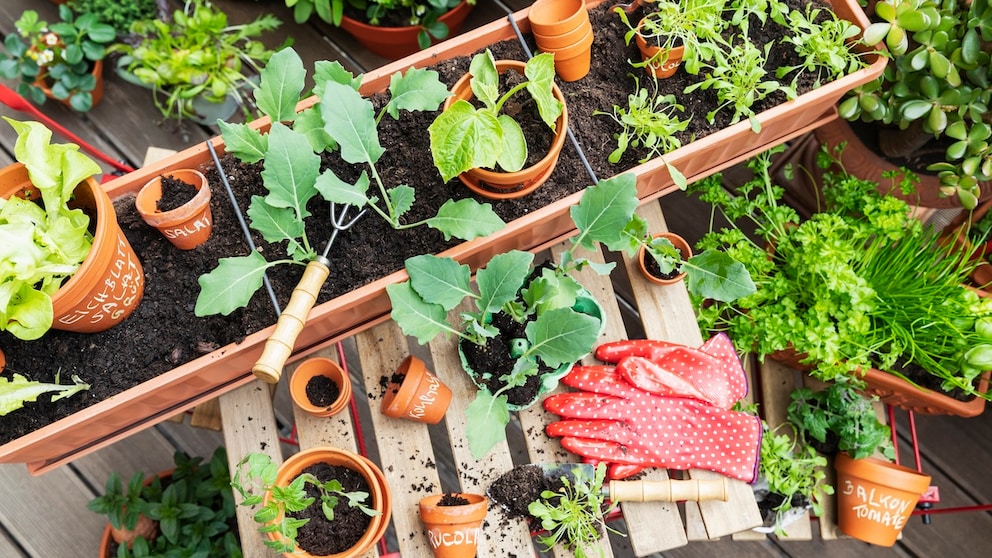May 4, 2025, 11:57 am | Read time: 4 minutes
Permaculture on the balcony? It can work! myHOMEBOOK spoke with organic balcony gardener Birgit Schattling about the opportunities, unique aspects, and best tips for sustainable gardening in pots, boxes, and containers.
Amid buzzing wild bees, blooming marigolds, and vibrant tomatoes, a small cosmos of diversity, enjoyment, and sustainability can emerge on a balcony. A permaculture balcony may seem a bit chaotic, but in truth, it has a system. Permaculture is a concept aimed at establishing sustainable, self-regulating, resilient systems based on cycles and a conscious use of resources. “Even in small spaces, you can practice permaculture — provided you adapt the design to the conditions. The limited space is the biggest limiting factor,” says Birgit Schattling, who also offers online courses on balcony gardening.
Observe First
The first step to permaculture on the balcony is observation: How does the light fall throughout the day and year? Where does the wind come from? Are there shadows from trees or buildings? Since the location of the balcony cannot be changed, it is all the more important to carefully observe the existing conditions.
“For example, if you like to sit outside in the morning, you can see if there’s a spot that gets sun at that time — and set up a seating area there. The same goes for evening use. This way, the available space can be sensibly adapted to your habits,” explains Schattling.
Water Supply
The water supply on the balcony must also be planned for permaculture. With an outdoor connection, it’s simple — everyone else needs creative solutions. The simplest option for open balconies is to collect rainwater using buckets, watering cans, or stretched tarps.
More effective is a rainwater collector connected to the downspout. Also possible: using an adapter to connect a hose to the kitchen or bathroom fixtures and run it through a door or window.
Plan Zones
A central idea of permaculture is zoning: areas are divided according to their frequency of use and function. This can be applied to the balcony, for example, by considering a hard-to-reach corner as a “wilderness zone” where chance plays a role. Wild plant seeds brought by wind or birds can grow undisturbed there. The active care area, on the other hand, is where you often spend time and can garden comfortably.
Think Big — Even with Pots
A typical beginner’s mistake: pots that are too small. “You should choose the largest possible pots if you want to enjoy them long-term,” emphasizes the expert. She recommends sturdy containers with water storage, preferably on wheels. Those who want to upcycle can also ask restaurants and snack bars for large food containers or find affordable secondhand pots through classifieds and exchange rings.
A design principle in permaculture is layering and stacking. Especially for the limited space on the balcony, spatial and temporal layering is helpful. Spatially, vertical growing with plant columns, grids, or hanging baskets can significantly increase the available space. Temporally, stacking mainly refers to growing winter vegetables.
Suitable Plants for Balcony Permaculture
Permaculture is about diversity and durability. That’s why so-called permaveggies — perennial edible plants — are particularly popular. These include perennial kale, buck’s-horn plantain, sorrel, Welsh onion, or scurvy grass. They not only reliably yield but also withstand frost.
Wild plants hold a special place for Birgit Schattling: “I deliberately grow ground elder, dandelion, and plantain on my balcony — because they are real powerhouses that require little care, provide edible leaves with high nutrient density, and offer habitat and food for beneficial insects.”
Classic vegetables like tomatoes, zucchini, and runner beans are also well-suited. The latter quickly grows tall, provides privacy, has pretty flowers, and attracts pollinators. In winter, kale, black cabbage, lamb’s lettuce, or Asian salads can provide fresh greens on the plate.

What’s Behind the “Chaos Gardening” Trend?

Indian balsam is spreading and threatening native species

Planting and care tips for lupins in the garden
Consciously Design Cycles
Permaculture also means integrating the concept of the cycle into everyday life — from seeds to harvest and back. Schattling shares: “For example, I collected wild rocket seeds in Berlin, sowed them on the balcony, harvested leaves, let the plant bloom, attracted bees, later harvested the seeds — and sowed them again the next year.” Over time, this creates an adapted, site-suitable plant. Kitchen waste and plant residues from the balcony can also be returned to the system through composting, such as with worm composters or Bokashi buckets.

